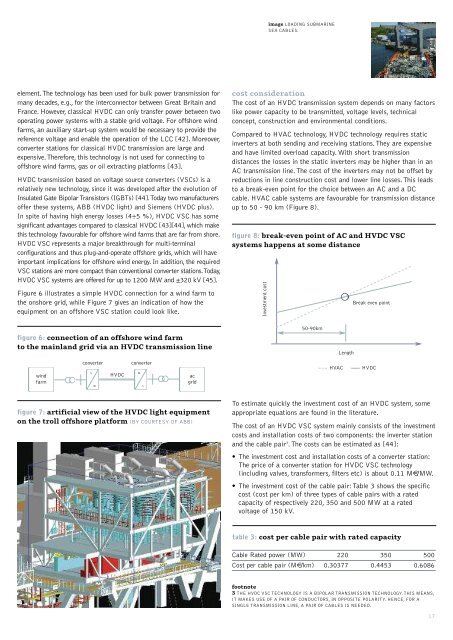offshore grids for wind power integration - Greenpeace
offshore grids for wind power integration - Greenpeace
offshore grids for wind power integration - Greenpeace
You also want an ePaper? Increase the reach of your titles
YUMPU automatically turns print PDFs into web optimized ePapers that Google loves.
image LOADING SUBMARINE<br />
SEA CABLES.<br />
© COURTESY OF ABB<br />
element.The technology has been used <strong>for</strong> bulk <strong>power</strong> transmission <strong>for</strong><br />
many decades, e.g., <strong>for</strong> the interconnector between Great Britain and<br />
France. However, classical HVDC can only transfer <strong>power</strong> between two<br />
operating <strong>power</strong> systems with a stable grid voltage. For <strong>offshore</strong> <strong>wind</strong><br />
farms, an auxiliary start-up system would be necessary to provide the<br />
reference voltage and enable the operation of the LCC [42]. Moreover,<br />
converter stations <strong>for</strong> classical HVDC transmission are large and<br />
expensive.There<strong>for</strong>e, this technology is not used <strong>for</strong> connecting to<br />
<strong>offshore</strong> <strong>wind</strong> farms, gas or oil extracting plat<strong>for</strong>ms [43].<br />
HVDC transmission based on voltage source converters (VSCs) is a<br />
relatively new technology, since it was developed after the evolution of<br />
Insulated Gate BipolarTransistors (IGBTs) [44].Today two manufacturers<br />
offer these systems, ABB (HVDC light) and Siemens (HVDC plus).<br />
In spite of having high energy losses (4÷5 %), HVDC VSC has some<br />
significant advantages compared to classical HVDC [43][44], which make<br />
this technology favourable <strong>for</strong> <strong>offshore</strong> <strong>wind</strong> farms that are far from shore.<br />
HVDC VSC represents a major breakthrough <strong>for</strong> multi-terminal<br />
configurations and thus plug-and-operate <strong>offshore</strong> <strong>grids</strong>, which will have<br />
important implications <strong>for</strong> <strong>offshore</strong> <strong>wind</strong> energy. In addition, the required<br />
VSC stations are more compact than conventional converter stations.Today,<br />
HVDC VSC systems are offered <strong>for</strong> up to 1200 MW and ±320 kV [45].<br />
Figure 6 illustrates a simple HVDC connection <strong>for</strong> a <strong>wind</strong> farm to<br />
the onshore grid, while Figure 7 gives an indication of how the<br />
equipment on an <strong>offshore</strong> VSC station could look like.<br />
cost consideration<br />
The cost of an HVDC transmission system depends on many factors<br />
like <strong>power</strong> capacity to be transmitted, voltage levels, technical<br />
concept, construction and environmental conditions.<br />
Compared to HVAC technology, HVDC technology requires static<br />
inverters at both sending and receiving stations.They are expensive<br />
and have limited overload capacity. With short transmission<br />
distances the losses in the static inverters may be higher than in an<br />
AC transmission line.The cost of the inverters may not be offset by<br />
reductions in line construction cost and lower line losses.This leads<br />
to a break-even point <strong>for</strong> the choice between an AC and a DC<br />
cable. HVAC cable systems are favourable <strong>for</strong> transmission distance<br />
up to 50 - 90 km (Figure 8).<br />
figure 8: break-even point of AC and HVDC VSC<br />
systems happens at some distance<br />
Investment cost<br />
Break even point<br />
50-90km<br />
figure 6: connection of an <strong>offshore</strong> <strong>wind</strong> farm<br />
to the mainland grid via an HVDC transmission line<br />
Length<br />
<strong>wind</strong><br />
farm<br />
converter<br />
~<br />
=<br />
HVDC<br />
converter<br />
=<br />
~<br />
ac<br />
grid<br />
HVAC<br />
HVDC<br />
figure 7: artificial view of the HVDC light equipment<br />
on the troll <strong>offshore</strong> plat<strong>for</strong>m (BY COURTESY OF ABB)<br />
To estimate quickly the investment cost of an HVDC system, some<br />
appropriate equations are found in the literature.<br />
The cost of an HVDC VSC system mainly consists of the investment<br />
costs and installation costs of two components: the inverter station<br />
and the cable pair 3 .The costs can be estimated as [44]:<br />
• The investment cost and installation costs of a converter station:<br />
The price of a converter station <strong>for</strong> HVDC VSC technology<br />
(including valves, trans<strong>for</strong>mers, filters etc) is about 0.11 M€/MW.<br />
• The investment cost of the cable pair:Table 3 shows the specific<br />
cost (cost per km) of three types of cable pairs with a rated<br />
capacity of respectively 220, 350 and 500 MW at a rated<br />
voltage of 150 kV.<br />
table 3: cost per cable pair with rated capacity<br />
Cable Rated <strong>power</strong> (MW)<br />
Cost per cable pair (M€/km)<br />
220<br />
0.30377<br />
350<br />
0.4453<br />
500<br />
0.6086<br />
footnote<br />
3 THE HVDC VSC TECHNOLOGY IS A BIPOLAR TRANSMISSION TECHNOLOGY. THIS MEANS,<br />
IT MAKES USE OF A PAIR OF CONDUCTORS, IN OPPOSITE POLARITY. HENCE, FOR A<br />
SINGLE TRANSMISSION LINE, A PAIR OF CABLES IS NEEDED.<br />
17

















